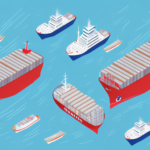What is ISF (Importer Security Filing) and How Does it Work?
The Importer Security Filing, commonly abbreviated as ISF, is a crucial program in international trade that aims to enhance supply chain security by requiring importers to submit detailed information about their cargo to U.S. Customs and Border Protection (CBP) before it arrives in the United States. According to CBP regulations, importers are required to file an ISF at least 24 hours before a shipment departs from the port of origin and 24 hours before it reaches the port of discharge in the United States.
The Purpose of ISF in International Trade
The overarching purpose of the ISF program is to strengthen the security of the global supply chain and prevent any potential terrorist attacks or security-related threats. As a part of the broader Customs-Trade Partnership Against Terrorism (CTPAT), ISF seeks to facilitate the flow of legitimate trade while mitigating risks associated with cargo security.
ISF provides CBP with advance information about shipments, enabling the identification of potential security risks and the implementation of preventive measures before shipments reach U.S. ports. By ensuring the safety and security of international trade, ISF helps build trust across borders, making trade smoother and more efficient.
An important aspect of the ISF program is its role in reducing cargo delays and disruptions. By submitting detailed information in advance, CBP can quickly identify and address potential issues with shipments, thereby preventing costly delays for both importers and exporters.
Moreover, the ISF program enhances compliance with U.S. customs regulations. By mandating detailed and accurate shipment information, the program ensures that all necessary documentation is in order and that applicable regulations are followed. This helps prevent costly fines and penalties for non-compliance and improves overall supply chain efficiency.
ISF Requirements and Regulations for Importers
Importers are required to file an ISF at least 24 hours before their shipment departs from the port of origin and 24 hours before it arrives at the port of discharge. CBP mandates that each ISF contains ten data elements that provide detailed information about the shipment, including:
- Manufacturer or supplier information
- Ship-to party information
- Container stuffing location
- Consolidator information, if applicable
- Importer of record number
- Commodity HTSUS number
- Country of origin
- Harmonized Tariff Schedule (HTS) number of the goods
- Container stuff date (often the sailing date)
- B/L or AWB number and the carrier of the shipment
In addition to these mandatory elements, importers may include optional elements such as a bill of lading number, unit quantity, or specific reference numbers to facilitate a smoother clearance process.
Failure to file an ISF can result in significant penalties and delays in the clearance process. Importers should be aware that CBP may impose liquidated damages for inaccurate or incomplete ISF filings, ranging from $5,000 to $10,000 per violation, depending on the severity.
Importers must have a thorough understanding of ISF regulations and stay updated on any changes. Collaborating with experienced customs brokers or freight forwarders can provide valuable guidance and support throughout the filing process.
Understanding the Different Components of an ISF Filing
Each ISF filing consists of two main components: ISF-10 and ISF-5. The ISF-10 includes the ten mandatory data elements mentioned earlier and must be submitted by the importer or their agent. The ISF-5 pertains to carrier and vessel information and is submitted by carriers to provide critical details to CBP, such as the vessel's name, voyage number, and scheduled arrival date.
The ISF-10 must be filed at least 24 hours before goods are loaded onto the vessel. Failure to do so can result in penalties and shipment delays. The ISF-5 must be filed no later than 48 hours after the vessel departs from the foreign port. This information is vital for CBP to ensure the safety and security of U.S. borders.
It's important to note that ISF filing is separate from customs entry filing. While ISF is required for all shipments entering the United States by vessel, customs entry filing is necessary for all shipments entering the country, regardless of the mode of transportation. Accurate and timely completion of both filings is essential to avoid customs clearance issues.
Common Mistakes to Avoid When Filing an ISF
Filing an ISF can be complex, and importers may encounter several challenges that can lead to delays or penalties. Common mistakes to avoid include:
- Failing to file the ISF on time or submitting it too late
- Providing incorrect or incomplete information
- Using outdated or inaccurate shipment data
- Submitting ISF in an incorrect format or using improper templates
- Engaging unauthorized, non-compliant, or unregistered service providers
ISF filing is not a one-time process. Importers must update their ISF information promptly, especially if there are any changes to the shipment or the initially provided information. Failure to update the ISF can result in penalties and clearance delays. Staying vigilant and promptly addressing any changes is crucial for compliance.
Benefits of Filing an ISF for Importers and Customs Officials
The ISF program offers several benefits for both importers and CBP officials:
- For Importers:
- Avoiding costly delays, fines, and penalties associated with non-compliance
- Efficiently managing inventory and ensuring timely delivery of goods
- Preventing unexpected expenses due to delays or additional charges
- For Customs Officials:
- Early identification and mitigation of potential security risks in the supply chain
- Avoiding unnecessary inspections and ensuring only safe, legitimate cargo enters the U.S.
- Facilitating secure trade and building trust within the global trade community
How to File an ISF Step-by-Step: A Comprehensive Guide
Filing an ISF involves several steps to ensure accuracy and compliance. Here is a step-by-step guide:
- Gather Necessary Information: Collect all relevant details about the shipment, including supplier information, commodity descriptions, and shipping dates.
- Validate Information: Ensure that all collected information is accurate and complete to avoid errors in the filing.
- Select a Service Provider: Choose a reliable service provider or customs broker to file the ISF on your behalf, or opt to file it yourself using approved platforms.
- Complete the ISF-10 Form: Fill out the ISF-10 form with the ten mandatory data elements and any applicable optional elements specific to your shipment.
- Submit the ISF: File the ISF with CBP at least 24 hours before the shipment's departure from the origin port or 24 hours before arrival at the U.S. port of discharge.
Tips for Choosing the Right Customs Broker to Help with Your ISF Filing
A competent customs broker can streamline the ISF filing process and help avoid costly mistakes. Consider the following tips when selecting a customs broker:
- Experience: Ensure the broker has experience handling the type of cargo you are importing.
- Registration and Compliance: Verify that the broker is registered with CBP and complies with all relevant regulations.
- References and Reviews: Check references and read reviews from other importers to gauge the broker's reliability and service quality.
- Cost Comparison: Compare quotes and fees from multiple brokers to ensure competitive pricing.
- Transparent Process: Choose a broker who provides clear information about the filing process, including timelines, costs, and deliverables.
The Impact of Non-Compliance with ISF Regulations on Importers
Non-compliance with CBP's ISF regulations can lead to severe consequences for importers, including:
- Significant fines and penalties
- Delays in cargo clearance
- Issuance of a Bond or initiation of enforcement actions by CBP
- Possibility of having to re-export cargo
With CBP intensifying its focus on supply chain security, it is essential for importers to remain compliant with all ISF regulations to avoid these repercussions and ensure smooth customs clearance.
Latest Updates and Changes to the ISF Program: What You Need to Know
The ISF program has evolved since its inception, with several updates to enhance its effectiveness:
- ISF-5 Filing Requirement: Implemented in June 2019, the ISF-5 requires carriers to submit additional information about the vessel and voyage, enhancing CBP's ability to assess security risks.
- Increased Penalties: The maximum penalty for non-compliance with ISF regulations has been raised to $5,000 per violation, emphasizing the importance of accurate and timely filings.
Staying informed about these updates is crucial for maintaining compliance and avoiding penalties. Regularly consult the official CBP website or trusted industry sources for the latest information.
Top Factors Affecting the Cost of Your ISF Filing
The cost of filing an ISF can vary based on several factors, including:
- Service Provider: Fees may differ between customs brokers and filing service providers based on their expertise and service levels.
- Volume of Goods: Larger shipments or higher volumes may incur higher filing costs.
- Customization: Shipments requiring tailored or specialized filing processes can increase costs.
- Mode of Transportation: Different transportation modes may have varying filing requirements and associated costs.
- Customer Support: Providers offering comprehensive support and additional services may charge higher fees.
Understanding these factors can help importers budget effectively and choose the most cost-efficient filing options.
The Future of ISF: Emerging Trends and Technologies in Supply Chain Security
As global supply chains become more complex, the ISF program is expected to evolve with emerging trends and technologies aimed at enhancing security and efficiency:
- Advanced Analytics and AI: Utilizing data analytics and artificial intelligence to detect and respond to potential security risks in real-time.
- Blockchain Technology: Implementing blockchain for greater transparency and traceability within the supply chain.
- Digital Automation: Adopting digital platforms and tools to automate ISF filing processes, reducing errors and improving speed.
These innovations are set to transform the ISF program and the broader supply chain ecosystem, making trade operations more secure, transparent, and efficient for all stakeholders involved.
For more detailed information on ISF and related regulations, visit the Shipscience ISF Guide.




















